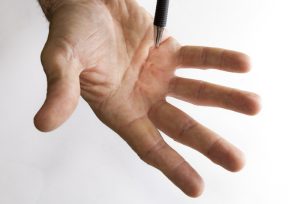Dupuytren’s Disease

What is it?
Dupuytren’s disease is the thickening of the fascia beneath the skin in the palm of the hand. The fascia is like a think canvas which acts to protect the vital structures in your hand and also to firmly keep hold of overlying skin – preventing it sliding and tearing off. The thickening of the fascia causes a contracture of fingers known as Dupuytren’s contracture. Note that the finger tendons lie deep to the fascia and are NOT involved in the disease.
Who gets it and what causes it?
There is thought to be a genetic component to the condition, as it seems to run in families and affect people of Northern European ancestry (Vikings)! There is also a link to certain conditions such as excessive alcohol consumption and diabetes, which may trigger the development of the condition. Typically men over 40 years of age are affected.

What are the signs and symptoms?
Pits, lumps and thickening are noted within the palm. At a later stage thick cords develop extending from the palm into the fingers, which cause the characteristic contracture of the fingers. Typically the ring and little fingers are affected. Difficulties are noted with carrying out one’s daily activities such as shaking hands, wearing gloves and washing your face.
Other regions of the body including the knuckles, the soles of the feet and the penis may be affected by a similar disease process.
What tests will I need?
The diagnosis can usually be made with a consultation, involving a medical history and clinical examination. No specialised tests are needed.
What is the treatment?
In mild cases, it may be that no treatment is necessary, however should the condition be more severe there are a few treatment options.
Injection therapy: Collagenase injections can weaken the fascia that is responsible for the formation of the thick cords within the palm in Dupuytren’s. Following the injection, a day or two is allowed to elapse to give time for the collagenase to act before the finger is straightened out.
Needle aponeurotomy (needle fasciotomy): involves cutting the thickened cords using a needle. This, like collagenase injections can be performed in the clinic.
In the more severe cases open surgery may be indicated. (see below)
What does the surgical treatment involve?
Surgery aims to remove the thickened fascia allowing the finger(s) to be straightened.
Mr. Naqui performs Dupuytren’s surgery at a number of hospitals around Manchester (see Hospitals page). The surgery usually lasts anything between 20 minutes to up to 2 hours depending on the extent of the disease. It is usually a day case procedure requiring local, regional or general anaesthetic (see FAQs page). The surgical scar is usually a zig-zag pattern extending from the palm into the base of the finger. Fine stitches will be used to close the wound. A bandage may be placed over the stitches. It is possible that a skin graft may be placed over the wound to reduce the chances of the contracture reappearing. The possible need for a skin graft will be discussed with you at the time of your consultation, well before surgery.
What happens after the surgery?
Taking simple painkillers such as paracetamol regularly for the first 2 days after the operation will help to relieve any post-operative pain. Your dressing will be reduced within 5 days. Stitches will be removed at 10-14 days after the operation either at your GP or at the hand clinic.
Finger exercises should be performed as directed by Mr. Naqui or the hand therapist. You may also be advised to wear a hand splint to minimise the chances of the condition reappearing.
When I can return to normal activity (work, driving, sports)?
If you perform heavy lifting at work it is advised to stay off work for 4-6 weeks; otherwise a period of 1-2 weeks off work is recommended to allow you to recover.
You are not advised to drive for at least 1 week after surgery.
Mr. Naqui will discuss your return to sport with you, depending upon your needs.
What are the complications of surgery?
Complications of Dupuytren’s surgery can include infection and rarely nerve injury. Sometimes complete removal of the contracture may not be possible and a residual contracture may still be apparent post-operatively. This is particularly noted in patients with contractures affecting the middle or end joints of the finger. Additionally, the contracture can recur, but should this occur, it infrequently requires further surgery.





